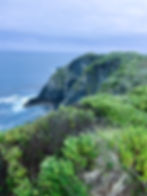Cabo De Hornos
- Debra McCoy Rogers
- Feb 26
- 3 min read
Updated: Mar 4
Cabo De Hornos, or Cape Horn, is the only place in the world where the Atlantic and Pacific Oceans meet. Located within Chile's Tierra del Fuego (Land of Fire), the world's southernmost national park, it is also the northern boundary of Drake's Passage, which separates Chile from Antarctica. Fortunately, my long-held desire to explore Patagonia led me to this meeting of the oceans, where I learned that it is a bucket-list destination for many.


The first documented navigation was by Captain Willem Schouten in 1616 for the Dutch East India Company. This expedition had two purposes. Firstly, to search for Terra Australis, the mythical Southern land which we now know as Antarctica, and secondly, to find a route to the East that bypassed the Spice Islands' trade restrictions. They accomplished the second objective, and subsequently, the cape was named Kap Hoorn after Schouten's birthplace, Hoorn, Holland.

Lying within the waters of Chile, the Chilean Navy is responsible for a station on Hoorn Island, which includes a residence, a lighthouse, a chapel, and a utility building. The Cape Horn Lighthouse remains a navigational aid in today's challenging environment.

The Chilean Navy only offers this particular lighthouse post to married men with families. The rationale? They feel the extreme isolation of the location necessitates family engagement for companionship amidst a challenging and remote environment. A family typically remains at this post for one year to tend the beacon and to maintain weather monitoring equipment at the adjoining weather station. Their supplies are restocked every 60 days if the weather permits; extreme winds often delay these deliveries. Attempts have even been made to grow food inside a greenhouse on the island; however, all attempts have failed; everything must be brought to them by ship. Only small expedition cruise ships can typically make this landing, so the family sees few people, and only during the short summer months; during the long winter, only the Navy deliveries arrive. We enjoyed meeting the family living there during our trip. This hardy family had requested to remain for a second year.
This cape has a reputation as one of the most challenging and dangerous places for navigation in the world, claiming the most ships lost at sea. This is a result of the collision of two powerful ocean currents, extreme winds, cold temperatures, unpredictable climates, and challenging underwater topography. Between the 15th and 20th centuries, more than 800 ships were shipwrecked and sank while trying to round the cape, resulting in the death of more than 10,000 sailors. This is the largest underwater cemetery in the world. A memorial, including a large sculpture by Chilean artist Jose Balcelis, presents the silhouette of an albatross in memory of those who have perished.

We were there in summer, yet the wind was brutal, the temperature cold, and yes, pieces of ice or snow were in the air. Not accessible overland, it must be reached by sea. Oftentimes, the winds are too strong for the ships to disembark. Even if you book a trip to visit, remember you may not be able to land. Early in the morning, when we visited, we thought our ship was one of those, but luckily, that did change. The weather is highly unpredictable.

On his voyage in 1892, Charles Darwin wrote, "On our weather-bow this notorious promontory in its proper form—veiled in a mist, and its dim outline surrounded by a storm of wind and water." Those words resonate with me. My son Ethan, in the photo, attests to the harsh weather conditions.

Today, Cape Horn's grandeur still draws explorers from across the globe. It remains a formidable challenge for mariners even today, a test of skill, courage, and respect for nature's forces. Its rich history of shipwrecks and challenges adds an element of awe and fascination to this meeting place of the Atlantic and Pacific Oceans.







